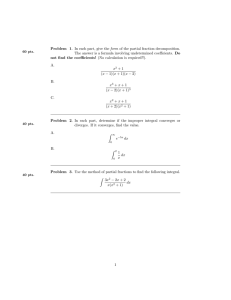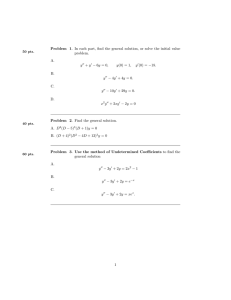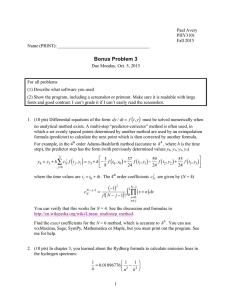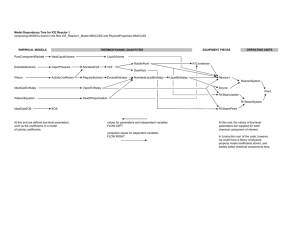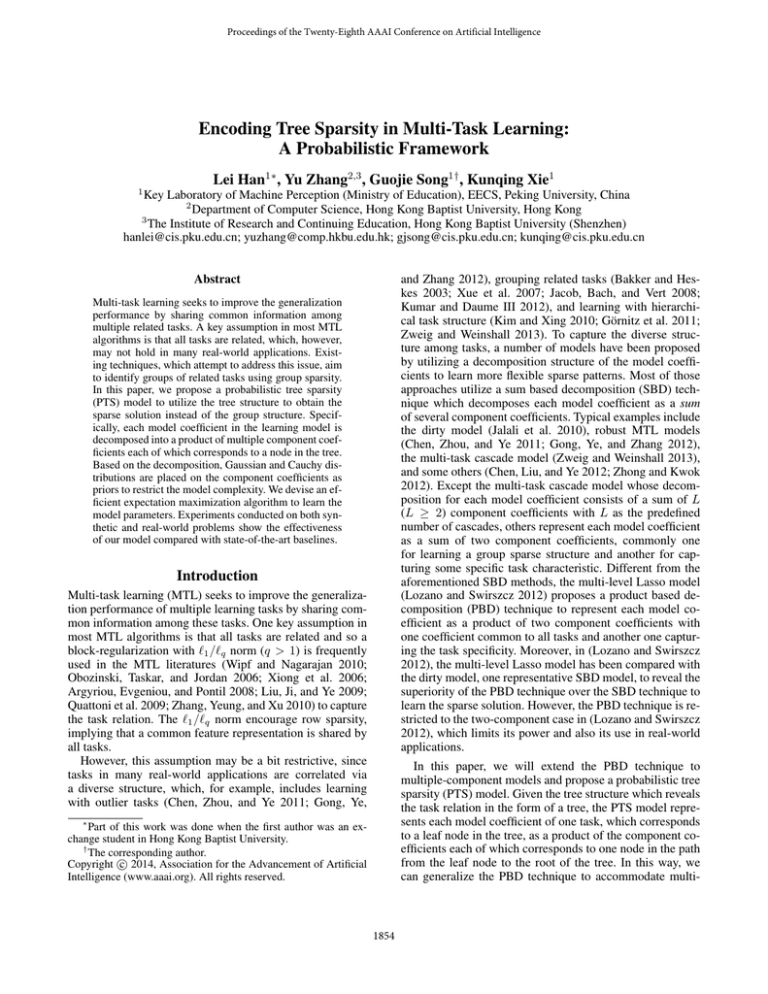
Proceedings of the Twenty-Eighth AAAI Conference on Artificial Intelligence
Encoding Tree Sparsity in Multi-Task Learning:
A Probabilistic Framework
Lei Han1∗ , Yu Zhang2,3 , Guojie Song1† , Kunqing Xie1
1
Key Laboratory of Machine Perception (Ministry of Education), EECS, Peking University, China
2
Department of Computer Science, Hong Kong Baptist University, Hong Kong
3
The Institute of Research and Continuing Education, Hong Kong Baptist University (Shenzhen)
hanlei@cis.pku.edu.cn; yuzhang@comp.hkbu.edu.hk; gjsong@cis.pku.edu.cn; kunqing@cis.pku.edu.cn
Abstract
and Zhang 2012), grouping related tasks (Bakker and Heskes 2003; Xue et al. 2007; Jacob, Bach, and Vert 2008;
Kumar and Daume III 2012), and learning with hierarchical task structure (Kim and Xing 2010; Görnitz et al. 2011;
Zweig and Weinshall 2013). To capture the diverse structure among tasks, a number of models have been proposed
by utilizing a decomposition structure of the model coefficients to learn more flexible sparse patterns. Most of those
approaches utilize a sum based decomposition (SBD) technique which decomposes each model coefficient as a sum
of several component coefficients. Typical examples include
the dirty model (Jalali et al. 2010), robust MTL models
(Chen, Zhou, and Ye 2011; Gong, Ye, and Zhang 2012),
the multi-task cascade model (Zweig and Weinshall 2013),
and some others (Chen, Liu, and Ye 2012; Zhong and Kwok
2012). Except the multi-task cascade model whose decomposition for each model coefficient consists of a sum of L
(L ≥ 2) component coefficients with L as the predefined
number of cascades, others represent each model coefficient
as a sum of two component coefficients, commonly one
for learning a group sparse structure and another for capturing some specific task characteristic. Different from the
aforementioned SBD methods, the multi-level Lasso model
(Lozano and Swirszcz 2012) proposes a product based decomposition (PBD) technique to represent each model coefficient as a product of two component coefficients with
one coefficient common to all tasks and another one capturing the task specificity. Moreover, in (Lozano and Swirszcz
2012), the multi-level Lasso model has been compared with
the dirty model, one representative SBD model, to reveal the
superiority of the PBD technique over the SBD technique to
learn the sparse solution. However, the PBD technique is restricted to the two-component case in (Lozano and Swirszcz
2012), which limits its power and also its use in real-world
applications.
Multi-task learning seeks to improve the generalization
performance by sharing common information among
multiple related tasks. A key assumption in most MTL
algorithms is that all tasks are related, which, however,
may not hold in many real-world applications. Existing techniques, which attempt to address this issue, aim
to identify groups of related tasks using group sparsity.
In this paper, we propose a probabilistic tree sparsity
(PTS) model to utilize the tree structure to obtain the
sparse solution instead of the group structure. Specifically, each model coefficient in the learning model is
decomposed into a product of multiple component coefficients each of which corresponds to a node in the tree.
Based on the decomposition, Gaussian and Cauchy distributions are placed on the component coefficients as
priors to restrict the model complexity. We devise an efficient expectation maximization algorithm to learn the
model parameters. Experiments conducted on both synthetic and real-world problems show the effectiveness
of our model compared with state-of-the-art baselines.
Introduction
Multi-task learning (MTL) seeks to improve the generalization performance of multiple learning tasks by sharing common information among these tasks. One key assumption in
most MTL algorithms is that all tasks are related and so a
block-regularization with `1 /`q norm (q > 1) is frequently
used in the MTL literatures (Wipf and Nagarajan 2010;
Obozinski, Taskar, and Jordan 2006; Xiong et al. 2006;
Argyriou, Evgeniou, and Pontil 2008; Liu, Ji, and Ye 2009;
Quattoni et al. 2009; Zhang, Yeung, and Xu 2010) to capture
the task relation. The `1 /`q norm encourage row sparsity,
implying that a common feature representation is shared by
all tasks.
However, this assumption may be a bit restrictive, since
tasks in many real-world applications are correlated via
a diverse structure, which, for example, includes learning
with outlier tasks (Chen, Zhou, and Ye 2011; Gong, Ye,
In this paper, we will extend the PBD technique to
multiple-component models and propose a probabilistic tree
sparsity (PTS) model. Given the tree structure which reveals
the task relation in the form of a tree, the PTS model represents each model coefficient of one task, which corresponds
to a leaf node in the tree, as a product of the component coefficients each of which corresponds to one node in the path
from the leaf node to the root of the tree. In this way, we
can generalize the PBD technique to accommodate multi-
∗
Part of this work was done when the first author was an exchange student in Hong Kong Baptist University.
†
The corresponding author.
c 2014, Association for the Advancement of Artificial
Copyright Intelligence (www.aaai.org). All rights reserved.
1854
represent the internal nodes. For any feature j, we have
wj1 = hj(1) hj(4) hj(5) , wj2 = hj(2) hj(4) hj(5) and wj3 =
hj(3) hj(5) .
ple component coefficients. By using the multi-component
PBD technique, if one component coefficient becomes zero,
then the subtree rooted at the corresponding node will be
removed from the solution regardless of other component
coefficients corresponding to the other nodes in the subtree,
which implies that a specific feature will not be selected by
tasks corresponding to the leaf nodes in that subtree. Specifically, the PTS model places Gaussian and Cauchy distributions for the component coefficients as priors to control
the model complexity. With the Gaussian likelihood, we devise an efficient expectation maximization (EM) algorithm
to learn the model parameters. Moreover, we discuss the relation between the SBD model and PBD model with multiple component coefficients by comparing our PTS model
with the multi-task cascade method. Results on synthetic
problem and two real-world problems show the effectiveness of our proposed model.
(a)
Figure 1: Examples of the tree structure over tasks.
Notations: For any node c in a tree T , D(c) denotes the set
of the descendants of c in the tree, A(c) denotes the set of
the ancestor nodes of c in the tree, and S(c) denotes the set
of children of a node c. L(T ) represents the set of the leaves
in T . I(T ) represents the set of the internal nodes in T . For
any set B, |B| is the cardinality of B. |T | denotes the number
of nodes in T .
Multi-Component PBD
Suppose there are m learning tasks. For the ith task, the
(k) (k) i
training set consists of ni pairs of data {xi , yi }nk=1
,
(k)
(k)
d
where xi ∈ R is a data point and yi ∈ R is the cor(k)
responding label. yi is continuous if the ith task is a regression problem and discrete for a classification problem.
For notational convenience, we assume that all tasks are regression problems. Similar derivation is easy to generalize to
classification problems. The linear function for the ith task
is defined as fi (x) =wTi x+bi .
Most of the MTL algorithms solve the following optimization problem:
min
W
ni
m X
X
(k)
(k)
L(yi , wiT xi
+ bi ) + λR(W),
(b)
The PTS Model
In this section, we propose a PTS model to utilize the priori information about the task relation encoded in the given
tree structure based on the multi-component PBD technique
introduced in the previous section.
The Model
First we propose a probabilistic model for the component
coefficients hj(c) for c ∈ T introduced previously.
(k)
(1)
The likelihood for yi
is defined as
i=1 k=1
(k)
yi
where W = (w1 , · · · , wm ) is the coefficient matrix, L(·, ·)
is the loss function, and R(·) is a regularizer that encodes
different sparse patterns of W. Here the columns of W represent tasks and the rows of W corresponds to features.
Given a tree which encodes the hierarchical structure of
tasks, we propose to decompose each element in W as a
product of multiple component coefficients based on the
tree. The tree is represented by T and the leaves in T
denote the tasks. Then the path from each leaf li corresponding to the ith task to the root r can be represented as
Hi = {li , · · · , r}. For any Hi and Hi0 , Hi ∩Hi0 denotes the
set of the nodes they share. The more nodes they share, the
more similar T
task i and task i0 tend
Smto be. All the paths share
S
m
the root, i.e. i=1 Hi = r, and i=1 Hi = T , where is
the union operator. Given a feature j, for any node c ∈ T ,
we define a corresponding component coefficient hj(c) . Now
we decompose wji , the (j, i)-th element in W, as
Y
wji =
hj(c) , j ∈ Nd , i ∈ Nm ,
(2)
(k)
∼ N (wiT xi
+ bi , σi2 ),
(3)
where N (µ, s) denotes a univariate (or multivariate) normal
distribution with mean µ and variance (or covariance matrix) s. Then we need to specify the prior over the parameter
wji in W. Since wji is represented by hj(c) as in Eq. (2),
instead we define priors over the component coefficients.
Specifically, two types of probabilistic priors are placed in
the component coefficients corresponding to the leaf and
internal nodes respectively. Given a feature j, for any leaf
li ∈ L(T ), we assume that the corresponding component
coefficient hj(li ) follows a normal distribution:
hj(li ) ∼ N (0, φ2j(li ) ).
(4)
For any internal node e ∈ I(T ), a Cauchy prior is placed
on the corresponding component coefficient hj(e) as
hj(e) ∼ C(0, φj(e) ),
(5)
where C(a, b) denotes the Cauchy distribution (Arnold and
Brockett 1992) with the probability density function defined
as
1
h
i,
p(x; a, b) =
2
πb x−a
+1
b
c∈Hi
where Nm represents the index set {1, · · · , m}.
Figure 1(a) provides an example of the tree. In this example, there are 3 tasks denoted by the leaves. Circles
1855
where a and b are defined as the location and scale parameters. The Cauchy prior is widely used for feature learning
(Carvalho, Polson, and Scott 2009; Daniel, Jose Miguel, and
Pierre 2013). Moreover, in order to obtain sparse hyperparameter φj(li ) , we place the Jeffreys prior (Qi et al. 2004)
over the φj(li ) :
1
p(φj(li ) ) ∝
, i = 1, . . . , m.
(6)
φj(li )
One advantage of using the Jeffreys prior is that the prior has
no hyper-parameters.
Eqs. (3)-(6) define the PTS model. In the next section, we
discuss how to learn the model parameters.
fied as
Q(Θ|Θ(t) ) = −
−
−
min
J=
h(E) ,φ(E)
−
d
X
X
where
(k)
c∈Hi
d X
m
X
h2j(li )
2φ2j(li )
d
X
=
(t)
1
p(φj(li ) )p(hj(li ) |φj(li ) )dφj(li )
2φ2
j(li )
R∞
(t)
p(φj(li ) )p(hj(li ) |φj(li ) )dφj(li )
0
1
(t)
[2hj(li ) ]2
ln φj(e) .
j=1 e∈I(T )
d
X
(10)
ln |hj(e) |,
(k)
e ∈ I(T ), x̄ji
(k)
(k)
= xji
(t)
Q
hj(c) , and
c∈Hi ,c6=e
(t)
ln(|hj(e) |+α) ≤
d
X
j=1
(t0 )
0
ln(|h(t ) | + α) +
j(e)
|hj(e) | − |hj(e) |
(t0 )
|hj(e) | + α
.
Thus, in the (t0 + 1)th iteration of the MM algorithm,
we only need to solve a weighted `1 minimization problem
(Candes, Wakin, and Boyd 2008; Wipf and Nagarajan 2010):
R∞
]=
X
li ∈D(e) k=1
j=1
Then we compute the following expectation as
|y, Θ
+ 1) + λ
ȳi = yi − bi . Problem (10) is non-convex since the
second term of the objective function is non-convex. To
solve this problem, we use the majorization-minimization
(MM) algorithm (Lange, Hunter, and Yang 2000) to solve
this problem. For numerical stability, we slightly modify Eq.
Pd
(10) by replacing the second term with j=1 ln(|hj(e) |+α)
where α is a tuning parameter. We denote the solution ob(t0 )
tained in the t0 th iteration in the MM algorithm as hj(e) .
Then, in the (t0 + 1)th iteration, due to the concavity property of the logarithm function ln(·), we have
(t)
2φ2j(li )
c∈Hi
d
X
j=1
p(φj(li ) |y, Θ(t) ) ∝ p(φj(li ) )p(hj(li ) |φj(li ) ).
E[
(7)
ni
d
X
1 X X
(k)
(k)
(ȳi −
hj(e) x̄ji )2
2
j=1
+λ
ln φj(e) .
0
ln φj(e) .
m ni
d
X
Y
1 XX
(k)
(k)
(yi −
xji
hj(c) − bi )2
2 i=1
j=1
X
h2j(e)
λ
ln ( 2
φj(e)
j=1 e∈I(T )
h(E)
In addition, we have
(t)
j=1 i=1
k=1
min J¯ =
j=1 e∈I(T )
1
βji h2j(li )
By setting the derivatives of J with respect to φ(E) to zero
and then get
φj(e) = |hj(e) |.
(9)
By plugging the solution in Eq. (9), we can simplify problem
(8) as
d
m ni
X
Y
1 XX
(k)
(k)
(yi −
hj(c) − bi )2
xji
2λ i=1
j=1
j=1 i=1
X
+ 1) −
d X
m
X
(8)
∝ ln p(y|h, σ) + ln p(h(E) |φ(E) ) + ln p(h(L) |φ(L) )
+ 1) −
d
X
d
X
+
where φ = {φj(c) }j∈Nd ,c∈T and Θ denotes the estimate of Θ in the tth iteration. By defining h(L) =
{hj(li ) }j∈Nd ,i∈Nm and h(E) = {hj(e) }j∈Nd ,e∈I(T ) , it is
easy to get
ln p(Θ|y, φ)
−
h2j(e)
ln ( 2
φj(e)
j=1 e∈I(T )
M-step: we maximize Eq. (7) to update the estimates of h,
b, and φ(E) . For the estimation of h(E) and φ(E) , we solve
the following optimization problem:
(t)
X
h2j(e)
ln ( 2
φj(e)
j=1 e∈I(T )
i
d
X
X
j=1 e∈I(T )
Q(Θ|Θ(t) ) = E[ln p(Θ|y, φ)]
Z
= p(φ|y, Θ(t) ) ln p(Θ|y, φ)dφ,
k=1
m ni
d
1 X X (k) X (k) Y
(yi −
xji
hj(c) − bi )2
2λ i=1
j=1
c∈H
k=1
In this section, we develop an EM algorithm (Dempster,
Laird, and Rubin 1977) to learn the model parameters except
σ = (σ1 , . . . , σm )T . In order to achieve model flexibility, σ
is treated as a tuning parameter and for simplicity, different
2
σi ’s are assumed to be identical, i.e., σ12 = · · · = σm
=λ
where λ is chosen via the cross validation method in our experiments. In the EM algorithm, φ(L) = {φj(li ) }j∈Nd ,i∈Nm
are treated as hidden variables and the model parameters
are denoted by Θ = {h, b, φ(E) } where h denotes the
set of all component coefficients, b = (b1 , . . . , bm )T , and
φ(E) = {φj(e) }j∈Nd ,e∈I(T ) . In the following, we give the
details in the EM algorithm.
E-step: we construct the Q-function as
d
X
the Q-function can be simpli-
i
Parameter Inference
∝−
1
,
(t)
[2hj(l ) ]2
By defining βji =
ni
d
d
X
X
|hj(e) |
1 X X
(k)
(k)
(ȳi −
hj(e) x̄ji )2 + λ
.
0)
(t
2
|+α
j=1
j=1 |h
li ∈D(e) k=1
.
j(e)
(11)
1856
Related Work
Problem (11) can be solved efficiently by some mature
Lasso-style solvers. Moreover, according to (Lange, Hunter,
and Yang 2000), the MM algorithm is guaranteed to converge to a local optimum.
For the estimation of h(L) , we need to solve m weighted
ridge regression problems with each one formulated as
min J˜ =
h(L)
Besides the existing SDB and PBD models, the tree-guided
group Lasso (TGGL) in (Kim and Xing 2010) addresses a
similar problem for multi-output regression where the structure among outputs is encoded in a tree as a priori information. The TGGL method is formulated as a group lasso
with the groups induced by the tree structure but the coefficient decomposition technique is not utilized in that model.
In TGGL, the sparsity pattern is induced by the groups defined in the tree structure, which differs from the tree sparsity in our method. In addition, the formulation of TGGL
is only for the multi-output case and not easy to extend to
the general multi-task setting. Some hierarchical MTL models (Daumé III 2009; Görnitz et al. 2011) are proposed to
exploit the hierarchical relations between tasks. However,
those methods are not for sparse learning and so their objectives are different from this work.
ni
d
d
X
X
1X
(k)
(k)
(ȳi −
hj(li ) x̃ji )2 + λ
βji h2j(li ) ,
2
j=1
j=1
k=1
(k)
(k)
where i ∈ Nm and x̃ji = xji
(12) has an analytical solution as
(12)
(t)
h
.
Problem
c∈A(li ) j(c)
Q
hj(li ) = (X̃Ti X̃i + Di )−1 X̃Ti ȳi ,
(1)
(n )
(1)
(n )
where X̃i = (x̃i , · · · , x̃i i )T , ȳi = (ȳi , · · · , ȳi i )T ,
and Di is a d × d diagonal matrix with λβji as the jth diagonal element.
For the estimation of b, we set the derivative of
Q(Θ|Θ(t) ) with respect to b to zero and get the solution
(t+1)
of bi
as
(t+1)
bi
=
Experiments
In this section, we conduct empirical experiments on both
synthetic and real-world problems to study the proposed
PTS method. Baselines used for comparison include the
multi-task feature learning (MTFL) model (Liu, Ji, and Ye
2009), the dirty model (DM) (Jalali et al. 2010), the multilevel Lasso (MLL) model (Lozano and Swirszcz 2012), the
tree-guided group Lasso (TGGL) model (Kim and Xing
2010), and the multi-task cascade (Cascade) model (Zweig
and Weinshall 2013).
ni
d
X
Y
1 X
(k)
(k)
(yi −
xji
hj(c) ).
ni
j=1
k=1
c∈Hi
Note that the Cauchy prior used in the internal nodes is to
make the solution sparse as shown in Lasso-style problem
(11). For the leaf nodes, the normal prior is used to get nonsparse solutions as shown in problems (12), since there is no
need for sparsity.
Synthetic Data
We first evaluate the proposed method on synthetic data. We
simulate a multi-task regression problem with m = 8 tasks
and d = 30 features. We assume all the learning tasks share
the same data matrix X, where X is a n × d matrix with
n = 100 samples. Each column of X is generated from a
normal distribution N (0, In ) where 0 denotes a zero vector
or matrix with appropriate size and In is an n × n identity
matrix. To simulate the tree sparsity pattern in the solutions,
we generate W according to Figure 2(b) where the dark elements denote non-zero coefficients and the white ones are
zero. In Figure 2(b), the columns correspond to the tasks and
the rows represent the features. Moreover, the corresponding
tree structure is plotted in Figure 2(a). Figures 2(c)-2(h) give
the sparse patterns in W with respect to different features.
The dark nodes in the trees represent the non-zero component coefficients in Eq. (2). All non-zero elements in W are
set to 0.8. The label matrix Y is generated as Y = XW +,
where is a noise matrix with each column generated from
N (0, σ 2 In ).
We use the mean square error (MSE) to measure the performance of the estimation on W, which is defined as
Pm
(wi − wi∗ )T XT X(wi − wi∗ )
MSE(W) = i=1
,
mn
Comparison between the Multi-Component
SBD and PBD Techniques
In this section, we discuss the relation between the multicomponent SBD and PBD techniques utilized in MTL. For
the SBD model, we take the multi-task cascade model in
(Zweig and Weinshall 2013) as a representative model. For
the PBD model with multiple component coefficients, to the
best of our knowledge, our PTS method is the first one.
We first compare the model complexity. For the multicomponent SBD model, component coefficients have the
same size as the model coefficients due to the sum operator. As in the multi-task cascade model, the model involves
Ldm parameters, where L ≥ 2 is the number of the predefined cascade. For the multi-component PBD model as introduced in this paper, there are only d|T | parameters, where
|T | = m + |I(T )| Lm. So the complexity of multicomponent PBD models is lower than that of the multicomponent SBD counterparts in terms of the model parameters.
Next, we examine the sparsity property. For the multicomponent SBD model, each model coefficient wji equals
0 if and only if all of its component coefficients are 0 or
the sum of the component coefficients is 0. In contrast,
in the multi-component PBD model, when any one of its
component coefficient equals 0, wji will become 0. From
this point of view, the multi-component PBD model is more
likely to learn sparse solutions.
∗
where W∗ = (w1∗ , · · · , wm
) is the ground truth in Figure
2(b). We also use two additional metrics to measure the performance of sparsity recovery: the number of zero coefficients that are estimated to be nonzero (i.e., #(Z → N Z))
1857
(a)
(b)
(c)
(d)
(e)
(f)
(g)
(h)
Figure 2: Illustrations in synthetic data. (a) Tree used to simulate W; (b) The simulated W; (c)-(h) Sparse patterns for different features.
Table 1: The performance of various methods over 30 simulations on the synthetic data in terms of mean±standard deviation.
σ=2
σ=3
MSE
#(Z → N Z)
#(N Z → Z)
MSE
#(Z → N Z)
#(N Z → Z)
MTFL
1.728±0.156
51.333±5.365
0.000±0.000
3.814±0.429
50.633±4.530
0.000±0.000
DM
1.727±0.156
51.367±5.549
0.000±0.000
3.804±0.442
50.833±4.488
0.000±0.000
MLL
1.632±0.158
37.533±7.655
0.200±0.407
3.669±0.422
40.500±7.807
2.300±2.103
and the number of nonzero coefficients that are estimated to
be zero (i.e., #(N Z → Z)).
We generate n samples for training as well as n samples
for testing. The tuning parameters in all models are selected
via another validation set with n samples. Table 1 shows the
performance of all the methods over 30 simulations. As indicated in Table 1, PTS outperforms all the other methods in
terms of MSE. All the methods have nice (#(N Z → Z)),
while the MLL method misidentifies some non-zero coefficients to be zero. Moreover, both the MLL and PTS models
have lower (#(Z → N Z)) than the other methods, implying that the PBD models are more likely to obtain sparse solutions. Figure 3 shows the W’s learned by different methods on the synthetic data when σ = 2. The black area denotes non-zero coefficients, while the white one corresponds
to zero coefficients. Again the PBD models, i.e., the MLL
and PTS models, show better recovery of the sparse pattern
compared with other methods.
(a)
(b)
Cascade
1.431±0.137
51.033±5.014
0.000±0.000
2.815±0.412
50.500±4.687
0.000±0.000
(c)
(d)
PTS
1.374±0.161
43.100±7.801
0.000±0.000
2.758±0.322
41.467±4.273
0.000±0.000
(e)
(f)
Figure 3: W learned from various methods in synthetic data when
σ = 2. (a) MTFL; (b) DM; (c) MLL; (d) TGGL; (e) Cascade; (f)
PTS.
to the expression levels of 18 genes in the plastidial pathway (labels). There are 118 samples. We perform 10 random
splits, each of which uses 60%, 20% and 20% samples for
training, testing and validation separately. All the variables
are log transformed and standardized to zero mean and unit
variance. Since there is no tree structure about the task relation, in the first setting we utilize the two-level tree in Figure
1(b) as the priori information. Moreover, we run a hierarchical clustering algorithm similar to (Kim and Xing 2010)
on the labels of all tasks to get a tree as the second setting.
The tree learned from the hierarchical clustering algorithm
is shown in Figure 4, where the leaves denote the tasks (i.e.,
the genes).
Table 2 gives the average MSE. Except the TGGL and
Microarray Data
In this experiment, we report results on microarray data
(Wille et al. 2004).1 The data is a gene expression dataset
with microarray data related to isoprenoid biosynthesis in
plant organism. All the learning tasks are regression problems which aim to find the cross-talks from the expression
levels of 21 genes in the mevalonate pathway (data features)
1
TGGL
1.448±0.188
49.467±5.770
0.000±0.000
2.850±0.307
48.600±5.203
0.000±0.000
http://www.ncbi.nlm.nih.gov/pmc/articles/PMC545783/
1858
Table 3: Average accuracy of various methods over 5 random
splits on the Cifar-100 data under different settings.
Methods
Multi-Task
Multi-Class
MTFL
64.45±0.56 14.18±0.46
DM
67.31±0.63 14.48±0.42
MLL
67.74±0.94 15.48±0.41
TGGL
67.80±0.56
Cascade 68.94±0.62 16.10±0.45
PTS
70.22±0.52 16.22±0.53
Figure 4: The tree learned from the hierarchical clustering algorithm in the microarray Data.
class as the positive set, and 5 examples from each class in
the rest of classes as the negative set. We randomly split the
data with 60%, 20% and 20% samples for training, testing
and validation separately. For the multi-class setting, we just
formulate it as multi-class classification problem which can
be viewed a special case of the multi-task setting with all
tasks sharing the same training data.
The average results over 5 random splits are reported in
Table 3. Since the TGGL model is only designed for the
multi-output problem as introduced previously, we only report its result in the 1-vs-rest setting. As shown in Table 3,
our PTS model has the best classification accuracy in both
multi-task and multi-class settings.
Table 2: Average MSE of various methods over 10 random splits
on the microarray data.
Methods
Two-level tree
MTFL
0.6342±0.0913
DM
0.6141±0.1104
MLL
0.6118±0.0908
TGGL
0.6139±0.0867
Cascade 0.6112±0.0826
PTS
0.6091±0.0804
Clustering based tree
0.6342±0.0913
0.6141±0.1104
0.6118±0.0908
0.6220±0.0941
0.6112±0.0826
0.5986±0.0885
PTS methods, the other models cannot utilize the given tree
structure and thus have the same results in both settings. In
the first setting, the DM, MLL, TGGL, Cascade and PTS
models are comparable with each other, and all of them outperform the MTFL model under the significance t-test with
95% confidence. In the second setting, the performance of
the PTS mthod has some improvement compared with the
first setting, and is better than that of the other methods, implying that the tree structure brings useful information about
the task relation for the PTS method. However, the predication error of the TGGL method which also utilizes the
tree structure increases after incorporating the priori information. One reason is that the TGGL and PTS models utilize
the tree structure in different ways. The TGGL model imposes a group Lasso regularizer for all the regression coefficients in a subtree rooted at each internal node. In the PTS
model, the component coefficient for an internal node only
determines whether the subtree rooted at this node should be
removed from the solution or not. If not, the sparse pattern
can be further determined by its descendants. Thus, the PTS
model is more flexible than the TGGL model by using the
multi-component PBD technique.
Conclusion and Future Work
In this paper, we proposed a probabilistic tree sparsity model
in which the sparsity is induced from a product decomposition of the model coefficients into multiple component coefficients. By using Gaussian and Cauchy distributions as the
priors on the component coefficients, we developed an efficient EM algorithm to learn the model coefficients. Experimental results on synthetic data and two real-world datasets
demonstrate the usefulness of the proposed method.
As one future direction, we will focus on alleviating the
assumption that the tree structure over the tasks should be
given as a priori information. We are interested in the utilization of some Bayesian models, e.g. Dirichlet process,
to identify the tree structure automatically from data. We
are also interested in the comparison between the proposed
model and some other sparse feature learning methods, e.g.
the sparse coding method (Goodfellow, Courville, and Bengio 2012).
Acknowledgement
This work is supported by the National High Technology Research and Development Program of China (No.
2014AA015103), the National Science and Technology
Support Plan (No. 2014BAG01B02), Natural Science Foundations of China (No. 61305071), and HKBU FRG2/1314/039.
Cifar-100
In this problem, we test the performance of various methods on the Cifar-100 dataset.2 This dataset consists of 50000
color images belonging to 100 classes, with 500 images per
class. The 100 classes are further grouped into 20 superclasses, from which we could obtain a tree structure over
the classes as a priori information. We test the data in both
multi-task and multi-class settings. For the multi-task setting we consider the 100 1-vs-rest classification tasks. For
each binary classification task, we use all 500 images of each
2
References
Argyriou, A.; Evgeniou, T.; and Pontil, M. 2008. Convex
multi-task feature learning. Machine Learning 73(3).
Arnold, B. C., and Brockett, P. L. 1992. On distributions
whose component ratios are cauchy. The American Statistician 46(1):25–26.
http://www.cs.toronto.edu/∼kriz/cifar.html
1859
Quattoni, A.; Carreras, X.; Collins, M.; and Darrell, T. 2009.
An efficient projection for `1,∞ regularization. In ICML.
Wille, A.; Zimmermann, P.; Vranová, E.; Fürholz, A.; Laule,
O.; Bleuler, S.; Hennig, L.; Prelic, A.; von Rohr, P.; Thiele,
L.; et al. 2004. Sparse graphical gaussian modeling of the
isoprenoid gene network in arabidopsis thaliana. Genome
Biol 5(11):R92.
Wipf, D., and Nagarajan, S. 2010. Iterative reweighted `1
and `2 methods for finding sparse solutions. IEEE Journal
of Selected Topics in Signal Processing 4(2):317–329.
Xiong, T.; Bi, J.; Rao, B.; and Cherkassky, V. 2006. Probabilistic joint feature selection for multi-task learning. In
SIAM International Conference on Data Mining.
Xue, Y.; Liao, X.; Carin, L.; and Krishnapuram, B. 2007.
Multi-task learning for classification with Dirichlet process
priors. The Journal of Machine Learning Research 8:35–63.
Zhang, Y.; Yeung, D.-Y.; and Xu, Q. 2010. Probabilistic
multi-task feature selection. In NIPS.
Zhong, W., and Kwok, J. 2012. Convex multitask learning
with flexible task clusters. In ICML.
Zweig, A., and Weinshall, D. 2013. Hierarchical regularization cascade for joint learning. In ICML.
Bakker, B., and Heskes, T. 2003. Task clustering and gating
for Bayesian multitask learning. The Journal of Machine
Learning Research 4:83–99.
Candes, E. J.; Wakin, M. B.; and Boyd, S. P. 2008. Enhancing sparsity by reweighted `1 minimization. Journal of
Fourier Analysis and Applications 14(5-6):877–905.
Carvalho, C. M.; Polson, N. G.; and Scott, J. G. 2009. Handling sparsity via the horseshoe. In International Conference
on Artificial Intelligence and Statistics, 73–80.
Chen, J.; Liu, J.; and Ye, J. 2012. Learning incoherent sparse
and low-rank patterns from multiple tasks. ACM Transactions on Knowledge Discovery from Data (TKDD) 5(4):22.
Chen, J.; Zhou, J.; and Ye, J. 2011. Integrating low-rank
and group-sparse structures for robust multi-task learning.
In KDD.
Daniel, H.-L.; Jose Miguel, H.-L.; and Pierre, D. 2013. Generalized spike-and-slab priors for bayesian group feature selection using expectation propagation. In International Conference on Artificial Intelligence and Statistics.
Daumé III, H. 2009. Bayesian multitask learning with latent
hierarchies. In UAI.
Dempster, A. P.; Laird, N. M.; and Rubin, D. B. 1977. Maximum likelihood from incomplete data via the em algorithm.
Journal of the Royal Statistical Society. Series B (Methodological).
Gong, P.; Ye, J.; and Zhang, C. 2012. Robust multi-task
feature learning. In KDD.
Goodfellow, I.; Courville, A.; and Bengio, Y. 2012. Largescale feature learning with spike-and-slab sparse coding. In
ICML.
Görnitz, N.; Widmer, C. K.; Zeller, G.; Kahles, A.; Rätsch,
G.; and Sonnenburg, S. 2011. Hierarchical multitask structured output learning for large-scale sequence segmentation.
In NIPS.
Jacob, L.; Bach, F.; and Vert, J.-P. 2008. Clustered multitask learning: A convex formulation. In NIPS.
Jalali, A.; Ravikumar, P.; Sanghavi, S.; and Ruan, C. 2010.
A dirty model for multi-task learning. In NIPS.
Kim, S., and Xing, E. P. 2010. Tree-guided group lasso for
multi-task regression with structured sparsity. In ICML.
Kumar, A., and Daume III, H. 2012. Learning task grouping
and overlap in multi-task learning. In ICML.
Lange, K.; Hunter, D. R.; and Yang, I. 2000. Optimization transfer using surrogate objective functions. Journal of
computational and graphical statistics 9(1):1–20.
Liu, J.; Ji, S.; and Ye, J. 2009. Multi-task feature learning
via efficient `2,1 -norm minimization. In UAI.
Lozano, A. C., and Swirszcz, G. 2012. Multi-level lasso for
sparse multi-task regression. In ICML.
Obozinski, G.; Taskar, B.; and Jordan, M. I. 2006. Multitask feature selection. Statistics Department, UC Berkeley,
Tech. Rep.
Qi, Y. A.; Minka, T. P.; Picard, R. W.; and Ghahramani, Z.
2004. Predictive automatic relevance determination by expectation propagation. In ICML.
1860


